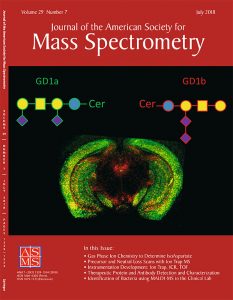
Mass Spectrometry Journal Cover
Featured Paper of the Month – January 2019.
Gangliosides are complex glycosphingolipids and have been implicated in brain development, neuritogenesis, memory formation, synaptic transmission and aging. Disruptions in ganglioside metabolism has been linked to several diseases such as Niemann-Pick C, and Gaucher disease types II, Alzheimer disease and Guillain-Barre syndrome. GD1s are the most abundant ganglioside species in the mammalian brain and consist of two structural isomers, GD1a and GD1b.Traditionally, the only way to analyze these isomers by mass spectrometry involved extraction and thus the researcher loses information about the location of the isomers in tissue. By combing an atmospheric pressure MALDI source and our matrix coating step, we were able to generate different fragment peaks that allowed us to distinguish the separate distribution of GD1a and GD1b in brain tissue sections by mass spectrometry imaging. The ability to image GD1b separately is important because the GD1 isomers are produced by different biosynthetic pathways. Thus, observed difference and changes, especially in disease models, may represent changes in one specific biosynthetic pathway.
Publication Information
AP-MALDI Mass Spectrometry Imaging of Gangliosides Using 2,6-Dihydroxyacetophenone. Journal Article
In: J Am Soc Mass Spectrom, vol. 29, no. 7, pp. 1463–1472, 2018, ISSN: 1879-1123 (Electronic); 1044-0305 (Linking).
